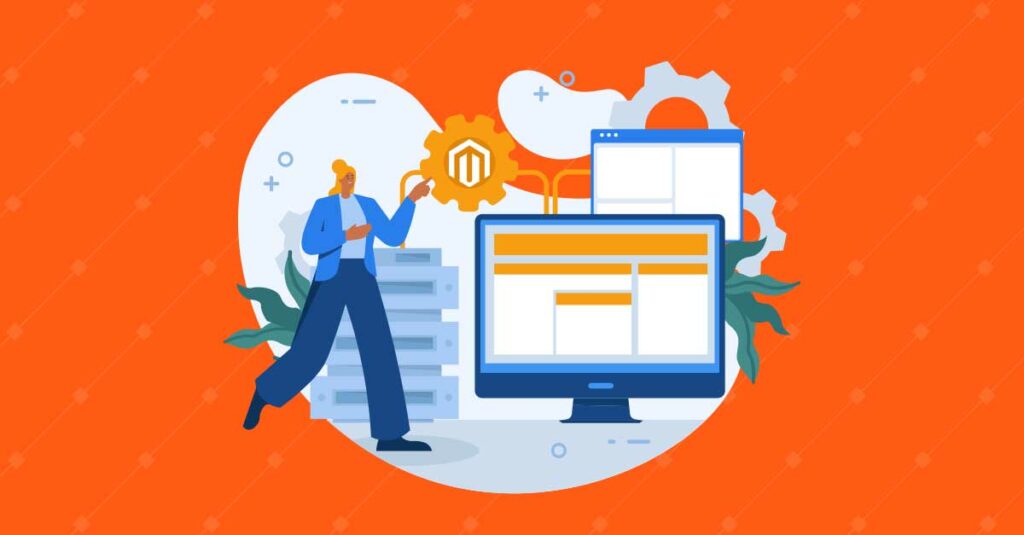Rapidly evolving market dynamics, new digital touchpoints, and buyers’ expectations to have an immersive e-commerce experience have driven businesses today to focus on innovation, speed, performance, scalability, and flexibility. That’s when the terms like Headless, microservices-based technology, and Composable Commerce came in!
MACH-architected e-commerce platforms leverage composable tech stacks and help businesses take a modular, best-of-breed approach. This cutting-edge architecture offers API integrations, excellent scalability, and an Omnichannel experience to users.
In this post, we will explore Composable Commerce and all the other technicalities you need to know about the composable approach.
Let’s begin:
What is Composable Commerce?
Back in the day, traditional Commerce was all about a vendor offering a one-size-fits-all solution to run an e-commerce store housing basic functionalities. But these platforms did not cater well to new digital touchpoints such as social media, IoT, marketplaces, mobile apps, etc.
A single vendor cannot offer extensive software components businesses need today to deliver exceptional user experiences. By the same token, the legacy tech stacks lack the innovation and flexibility required to keep up with cutting-edge merchandising.
What is the solution to this problem?
Composable Commerce is a new ecommerce approach that involves composing (combining) disparate PBCs (Packaged Business Components) to form a customized tech stack to satisfy each unique business need.
The composable architecture leverages modern technologies like MACH (Microservices, APIs, Cloud, and Headless) and JAMstack (JavaScript, APIs, and Markup) to compose PBCs together in a seamless manner. These platforms are highly flexible, scalable, and agile.
This Gartner report first introduced the term “Composable Commerce” in 2020, predicting that by the year 2023- businesses adopting Composable Commerce will outshine their competitors by 80% in the speed of new feature implementation.
What are PBCs (Packaged Business Capabilities)?
PBC is typically a standalone, third-party feature or capability of an application. However, PBCs could be considered as building blocks of your tech stack, housing their own business logic and data. They communicate with other components in the stack via APIs.
Packaged Business Capabilities could be built meticulously for shopping carts, checkouts, promotions, processing payments, managing ecommerce subscriptions, shipping, adding content to the website, etc.
PBCs may come from various vendors but customers experience them as “one’” through a single composable ecommerce store.
What is the difference between PBC and Microservice?
PBCs and microservices are often used interchangeably, which isn’t quite right.
A microservice is an architectural approach to software development where an application is arranged with loosely coupled, small independent services. These services interact via well-defined APIs.
PBCs, on the other hand, are designed to fulfill a single business requirement and may comprise one or more microservices.
Key Tenets of a Composable Commerce:
- Modular: Each component in the architecture- such as CRM system, shopping cart technology, analytics, shipping platform, etc. is independently pluggable, scalable, and replaceable. Composable Commerce is always modular- you can replace, add or remove any component without affecting other ones.
- Open: No vendor lock-ins. No monolithic approach. Applications seamlessly integrate with other applications you’re using or will be using. Businesses are free to use services from diverse vendors.
- Flexible: Composable Commerce provides flexibility to build a custom tech stack as per your unique business needs to deliver exactly what your buyers expect, that too across multiple channels. Moreover, you can scale your application up or down as your environment changes.
- Business-centric: Create web apps and software solutions that align with your business objectives. The fully customizable platform allows you to respond to the changing market dynamics faster with fewer unexpected issues, thereby reducing costs and boosting innovation. You can seamlessly add new functionality to your eCommerce store, without having to completely switch to a new platform.
Benefits of Composable Commerce:
Composable Commerce allows you to build a customized tech stack with flexible backend and immersive frontend experiences as expected by customers. It aids faster TTM, and agile delivery, and helps create truly Omnichannel experiences – be it across social media, voice search, mobile, web, retailer sites, etc.
Pleasant customer experiences
Composable Commerce allows you to tailor frontend experiences by personalizing UX and applications via dynamic components such as promotions, product recommendations, etc.
Innovation and Agility
Implement new business models by composing unique solutions with complete control over innovation and iteration. Composable Commerce offers out-of-the-box PBCs to integrate and deploy in a seamless and quick manner.
Exceptional scalability
Businesses can scale any component up or down independently or extend it with new functionality and custom logic to satisfy unique business requirements. This is possible without any vendor lock-ins.
Rapid Integrations
Composable Commerce architecture contains diverse PBCs that can leverage the power of out-of-the-box integrations to orchestrate together and help businesses solve more complex challenges.
Cost-effective
Businesses can compose their own tech stack as per the functionality they want, eliminating the need to pay for services they won’t use. Besides, composable commerce solutions reduce operational costs in the long run by leveraging modern technologies and boosting internal operational efficiencies.
Easy for Developers
Composable approach is a boon for development teams as they don’t have to worry about complexities when replacing, plugging, or removing any component within the system. It makes it all easier and faster; besides full-stack upgrades become hassle-free as well.
How to Get Started with Composable Commerce?
1. Preparing the Team for Implementation
Composable Commerce is tremendously beneficial; however, it requires technical expertise to some extent. Before you adopt the composable approach, make sure to prepare your team for the following operations:
- Leverage cutting-edge technologies like JAMstack, React, Next.js, etc.
- Create seamless, cohesive UI, UX, and designs where all services blend well together, as components come from various vendors.
- Implement API-first approach. Integrate backend components via APIs.
2. Map out Business Objectives
Composable commerce approach is all about choosing your desired solutions and composing them together to cater to business objectives. However, entirely replacing your current technical architecture can be overwhelming and time-consuming.
Hence, it is better to prioritize the functionality and features you would like to integrate into your eCommerce store.
- Prioritize key issues and begin to decompose the monoliths by choosing best-of-breed components that address monolithic issues.
- Map out high-priority composable features and functions that will positively affect your ROI and business goals and choose the ideal API-driven solutions accordingly.
- Map out your company architecture into multi-field cross-functional teams of stakeholders. This will help you align your teams, PBCs, and business goals together.
- Employ best agile practices to deploy highly iterative and faster implementations that align well with your business initiatives.
3. Selecting the right Composable Commerce Platform
Getting started with composable commerce can be overwhelming, but choosing the right platform will make it easier. It will help you curate your custom solution from the components of your choice. Keeping PBCs at the center choose a platform that focuses on building an interoperable, modular architecture.
Here are some of the things to consider when choosing the right composable commerce platform:
- Faster and Easy Set up: Composing a custom tech stack can be intimidating- but not with the right composable commerce platform. Look for a platform that aids faster and easy setup with a seamless addition of components. In fact, some composable commerce platforms offer pre-built components to aid faster implementation.
- Flexible: To reap maximum benefits of composable commerce approach, make sure to look for a platform that does not limit the type or number of components you can add to it. This ensures you have maximum scalability and flexibility to create your own custom tech stack, even in the future if you decide to add new functionalities.
- API-First: API-first platform will take a product-centric approach to API connectors, right from the beginning. Meaning, the platform won’t create a software solution and then take desired APIs to make it work with other services. Rather, it will take an API-first approach right from the start and treat API as a product itself, making them consistent and reusable.
- Pricing: Choose a composable commerce platform that is cost-effective in the long run, especially for SMEs (small and medium enterprises). Traditional ecommerce platforms can prove expensive in the long run, seeing their operational inefficiencies.When choosing a platform, consider its subscription fee, the licensing fee for third-party components, along with implementation, training and support costs.
- Solid Customer Support: For any platform to work seamlessly, you require solid customer support. A composable commerce platform comprises multi-vendor PBCs, but often provides a single point of contact for any support issues. Consider this factor when choosing the right platform.
Limitations of Composable Commerce
Composable Commerce implementation requires organizations to have digital maturity. Here are some of the limitations the composable approach may pose:
Managing multiple vendors
Every time you add new functionality, you’ll have to deal with vendors for terms & conditions, negotiations, purchase agreements, etc. Further, you will have to integrate these PBCs with your existing stack seamlessly.
Vendors have their own SLAs; hence you need to make sure to consider their operational capability in handling traffic spikes, resource demands, and other emergencies.
Create cohesive UI
Composing multiple PBCs together requires businesses to create a cohesive, well-blended interface and UX on top of these components to make them appear compelling. Sometimes, this process can be daunting and time-consuming.
Costs and complexities
Introducing new functionalities to your ecommerce stack can overwhelm your teams, as they have to learn the software and explore its capabilities. Learning core features and functions can be overwhelming, especially during implementation. This can add to the training costs.
Implementing composable commerce requires high digital maturity along with strong cross-functional collaboration between skilled developers. Hiring expert developers that are well-versed in the composable approach can be expensive as well.
Architectural change
Switching to composable commerce architecture may require you to change the monitoring and infrastructure tools as well for PBCs, which may add to the total cost of ownership.
Headless Commerce decouples the front-end and back-end of e-commerce architecture to provide high flexibility and speed up the development process. This eliminates the need to constantly switch between website parts and uses APIs to easily add products and manage the storefront.
Composable Commerce goes one step ahead of Headless by pulling in any modular PBC to satisfy unique business needs. In composable commerce, PBCs don’t affect other components in the stack, making it easier to independently plug, replace or remove them.
A digital commerce platform is a primary channel where customers directly interact with businesses via multiple touchpoints such as:
- Mobile apps
- Marketplaces
- Desktop and mobile storefronts
- IoT such as smartwatches, smart speakers, etc.
Organizations must keep up with ever-growing customer expectations, behaviors, and market needs. This drives the demand for Composable Commerce for B2B as it caters to the need for fast responses, Omnichannel support, and personalized and highly engaging digital experiences.
Monoliths have their front-end and back-end tightly coupled together making their architecture very rigid. They lack the scalability, flexibility, and agility required to implement changes faster.
How Does Ignitiv help?
Switching from monoliths to a Composable Commerce platform and the complexities involved in the re-platforming process- all of this can be difficult. But the right platform will help you migrate to composable commerce incrementally and efficiently with fewer adversities.
Ignitiv’s powerful cloud-native architecture, MACH alliance, detailed API documentation, an expert panel of developers, and highly scalable approach make your digital transformation journey a breeze at every stage!
Our API-first ecommerce platform takes the best-of-breed approach to help you integrate robust third-party, multi-vendor PBCs in your custom composable storefront and deliver immersive user experiences.
Want to know more about our Composable Commerce services? Get in touch with us today!








